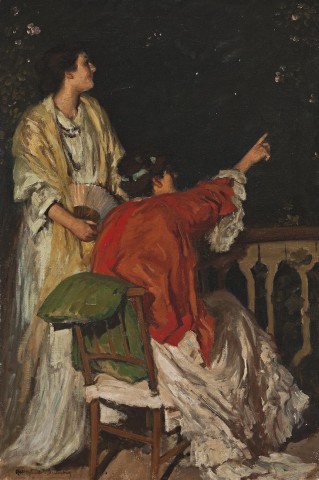THE FALLING STAR, c.1909
RUPERT BUNNY
oil on canvas
81.0 x 54.0 cm
signed lower left: Rupert C. W. Bunny
Mr J.M.C. Forsaythe, Sydney
Thence by descent
Mrs Phyllis Leishman, New South Wales
Christie's, Sydney, 6 October 1976, lot 325 (as 'Two Ladies on a Balcony')
Private collection
Christie's, London, 26 October 1983, lot 125 (as 'Two Ladies on a Balcony, Looking at the Stars')
Blue Boy Art Gallery, Melbourne
Private collection
Blue Boy Art Gallery, Melbourne
Ken and Rona Eastaugh, acquired from the above in 1985
Private collection, Melbourne, acquired from the above in 2009
Days and Nights in August, The Baillie Gallery, London, 22 April – 12 May 1911, cat. 10
Exhibition of Pictures by Rupert Bunny, Athenaeum Hall, Melbourne, 24 July – 14 August 1911, cat. 81
Exhibition of Pictures by Rupert Bunny, Lawson & Little Galleries, Sydney, 22 September – 7 October 1911, cat. 53
‘On Rupert Bunny’s Exhibition’, VAS, Melbourne, no. 2, 1 August 1911, p. 6
Souter, D. H., ‘Rupert Bunny and His Pictures’, Art and Architecture, Sydney, vol. VIII, no. 2, September – October 1911, p. 349
Eagle, M., The Art of Rupert Bunny, Australian National Gallery, Canberra, 1991, pp. 72, 78
Thomas, D., The Life and Art of Rupert Bunny: A Catalogue Raisonné, Thames and Hudson, Melbourne, 2017, vol. II, cat. O301, p. 44
When The Falling Star, c.1909 was shown in Rupert Bunny’s solo exhibition at London’s Baillie Gallery in April of 1911, he was hailed as ‘the greatest figure painter that Australia has produced’.1 The writer for The British-Australasian added that Bunny ‘holds an assured position among the leading artists in Paris’. Such praise was not alone. Earlier in the month, Bunny’s paintings and forthcoming exhibition were featured over two pages in London’s Black and White magazine under the heading, ‘A Fresh Note in Modern Figure Painting’.2 Some of Bunny’s then finest works were illustrated, including Après le Bain, c.1904, now in the Musée du Luxembourg, Paris and Une Nuit de Canicule, c.1910, which was later to break the $1million barrier for an Australian painting sold at auction.3 The London writer described Bunny as ‘a young Australian artist, whose choice of subject and methods of treatment single him out from the generality of modern painters without reference to his masterly technique and brilliancy of colouring’. Admiration for the ‘sensuous elegance of his work’ is supported by many of the paintings in the exhibition, especially The Green Caterpillar, c.1908, a work of special beauty.4
While narrative in Bunny’s paintings is reserved for the senses, their enveloping presence in his art is part of its magic. Delight in the caress of light on flouncy dresses, the feel of silk, intimate conversation, the indulgent warmth of a summer night in August. Others in this series evoke music by title, colour and composition as in The Song in the Distance, c.1909 (Queensland Art Gallery, Brisbane) and A Nocturne of Chopin, c.1908/9 (National Gallery of Australia, Canberra). The Falling Star adds another element – excitement. The two women, one seen from behind, the other a side view, strike an informal note, composed to invite the viewer’s participation. Contrasted against the pulsating darkness of the summer evening, you can almost feel the warmth of the night air. Yet, like the falling star, all is transient. The falling star has long been a token of good luck – and seemingly lots of other things. The wish you make might come true. Bunny’s favourite model, his beautiful wife Jeanne, attracts attention by her action and the focus on his favoured colours of red and green. When shown in Bunny’s 1911 exhibitions in Melbourne and Sydney, The Falling Star was singled out for mentioned by the critics.5 The writer for The V.A.S. asked enticingly, ‘ … is it a little like Paul Veronese?’.6
Throughout his life, Bunny was inclined to work in series – classical mythologies, in the gardens or on the beach, a new book or indoor indolence, red and white striped blinds as the balcony balanced life between indoors and out, then late mythological decorations and the dreamlike landscapes of spring in the south of France. Their constant was beauty. The first decade of the twentieth century saw the full flowering of la belle époque, centered on Paris. Elegance, feminine beauty and fashion achieved their apogee. Bunny’s paintings captured all.
1. ‘Art Notes’, British-Australasian, London, 27 April 1911, p. 16
2. ‘A Fresh Note in Modern Figure Painting’, Black and White, London, 15 April 1911, pp. 90 – 91
3. Leonard Joel, Melbourne, 2 November 1988, lot 125, sold for $1,250,000
4. Black and White, op. cit., p. 91. The Green Caterpillar, (La Chenille Vert), c.1908, sold for $516,000 at Sotheby’s, Melbourne, 17 May 2011, lot 75
5. ‘On Rupert Bunny’s Exhibition’, VAS, Melbourne, no. 2, 1 August 1911, pp. 6 – 7; and
Souter, D. H., ‘Rupert Bunny and His Pictures’, Art and Architecture, Sydney, vol. VIII, no. 2, September – October 1911, p. 349
6. The V.A.S., op. cit., p. 6
DAVID THOMAS
